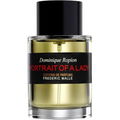Camille Goutal, as the daughter and occasional representative of the house founded by her mother Annick Goutal, must have thought twice about releasing an immortelle fragrance: Sables (1985) is the historical reference in the immortelle field and a benchmark that is hard to surpass, and it is also one of the few exceptions in the much-cited Goutal watercolor palette.
When the Goutal brand was acquired by the Amoré Pacific Group years ago, the mandatory re-packaging redesign took place, as it often does; everything was supposed to appear lighter, tidier, and more reduced, very much in line with the zeitgeist (especially Sables had a hard time during those years - which fortunately was easy to recognize thanks to the redesign). In a September 2023 interview (http://tinyurl.com/mrx5dj6p), Kay Lee, the Managing Director responsible for Goutal, also addresses these circumstances: “Since Amoré Pacific acquired the brand in 2011, Goutal has undergone several managerial changes, each of which had a different vision for the brand.” … “…The brand needs to be what it was when it was founded in 1981…” and even suggests a revival of the fantastic Vétiver (1985), but let's wait and see what exactly Ms. Lee's ideas are and whether this re-re-re-engineering will succeed. At least Sables has been pleasantly improved in recent years since it moved back into a cylindrical bottle.
Sables and the Goutal brand, Sables and Annick Goutal, whose daughter, Camille Goutal, and the perfumer Isabelle Doyen are all names that swirl around in a closely intertwined orbit; Annick Goutal was apparently primarily supported in the early days (including with Sables and the aforementioned Vétiver) by the perfumer Henri Sonoma and only later by Doyen. Whether there is now seemingly a break with the Goutal house and the ownership structure, or whether Voyages Imaginaires is just an organic spin-off of the two ladies is open, but Camille Goutal and Isabelle Doyen are the official co-authors of L'Eau des Immortels.
So much for the pretext … and right off the bat: there are indeed similarities between L'Eau des Immortels and Sables, plenty of them. With its phonetic closeness, the name L'Eau des Immortels almost reaffirms this literal kinship: for years, Sables, lacking alternatives, was simply the ‘immortelle water,’ or the ‘Eau des immortelles’ and here this relationship is challenged or claimed, look here, I, Annick’s daughter, defend her legacy and, in true family tradition, create an immortelle fragrance with a statement and pragmatically call it L'Eau des Immortel(le)s.
Everything is also present: the lush helichrysum note, emphasizing the character of a high-quality immortelle absolute, which smells different and much deeper than the plant itself, but has also clearly conditioned the widespread opinion of how an immortelle note should smell in perfumes. Very few immortelle fragrances correspond to the profile of the plant. The amber-like, spicy aspects, the light fenugreek and maple syrup associations, the vegetable, Mediterranean, and subcontinental notes, the hint of tobacco and hay, all facets that numerous other authors have elaborated in detail in individual fragrances (see my other Détour texts or corresponding collections), are all present here in balanced proportions. If Sables were no longer available, L'Eau des Immortels could indeed take on a worthy successor role.
Fortunately, Camille Goutal was aware of this loaded or rather special proximity, and Isabelle Doyen is too clever of a perfumer to merely design a shiny Sables offspring; the successful trick in L'Eau des Immortels is an emphasis and expansion of the patchouli note already present in Sables. This is intensified here, the patchouli unfolds its camphor-like aspects more clearly and is supported by a dark cocoa note. This combination, patchouli and dark, chocolate-like, was brilliantly implemented by Christopher Sheldrake in Bornéo 1834 (2005), whose roots lie in Vétiver Oriental (2002) and whose popularity peaked with Coromandel Eau de Toilette (2007) before it was unfortunately ruined again as Eau de Parfum (2016). Yes, a cross between Sables and Bornéo 1834, perhaps in a ratio of 70:30, is how I would outline L'Eau des Immortels. The whole thing harmonizes, yes, works surprisingly well. In every moment when I tell myself how close it is to Sables, this patchouli/cocoa note chimes in, like a reliable corrective, and brings L'Eau des Immortels back to its own place. At the same time, the ever-present immortelle prevents one from having to think too much about Bornéo 1834. This back and forth lasts for hours; for an ‘all natural’ perfume, L'Eau des Immortels holds up very well, also due to its proximity to Sables, or better, thanks to the use of immortelle absolute. Sweet or even gourmand, the whole thing never becomes: Goutal and Doyen unreservedly rely on immortelle in all its bulky size, its characteristics, and charm. The increasing trend to mention an immortelle note only as a lightly ambered filler, as happens with so many new fragrances, is fortunately far from the ladies. The cocoa note is also slightly bitter, which in turn supports the bitter facets of the immortelle absolute. The ease with which the two defining facets of the fragrance complement each other is impressive; one could say someone knows their immortelles here, Camille Goutal due to family ties, and Isabelle Doyen as an experienced perfumer in exchange with both Goutals. Many hours later, the remnants of L'Eau des Immortels still remind me of another, unfortunately discontinued all-natural immortelle fragrance, Karine Vinchon-Spehner’s Maquis Exquis & Immortelle (?).
Aside from the fact that the combination of immortelle/patchouli/cocoa simply works here, it also makes the perfume more accessible than Sables for a broader audience - Ramsauerin’s remark here in the statements captures this well; still, I would prefer Sables, especially in the more recent versions. Its cult status is unlikely to be reached by L'Eau des Immortels - too many very good fragrances that have more or less fully dedicated themselves to immortelle have appeared in the meantime, such as the beautiful Immortelle Corse (2019), which plays out a similar duality of two complementary accords, or the quasi-encoded and much more ambiguous immortelle-heavy fragrances from Serge Lutens (2017, 2018, 2021); also, Sables was long considered a relatively ‘normal’ perfume in Goutal's lineup and not, as here, as a rather high-priced segment in very specialized distribution. All in all, a very digestible, well-thought-out, and carefully executed newcomer in the immortelle field, whose proximity to the mentioned Sables is easily understandable due to the personnel involved.






 Immortelle
Immortelle Labdanum
Labdanum Benzoin
Benzoin Tonka bean
Tonka bean Amyris
Amyris Bergamot
Bergamot Vanilla
Vanilla







 TheDunkPapa
TheDunkPapa Celsa
Celsa Nordicskye
Nordicskye ElAttarine
ElAttarine SchatzSucher
SchatzSucher Ergoproxy
Ergoproxy Jeob
Jeob Rivegauche
Rivegauche CharlAmbre
CharlAmbre Wisivc
Wisivc








